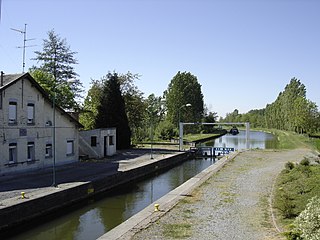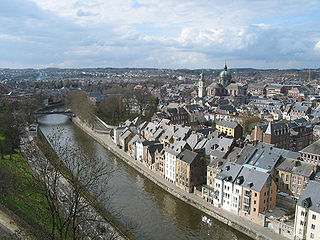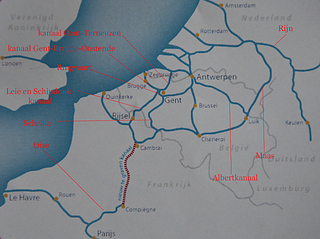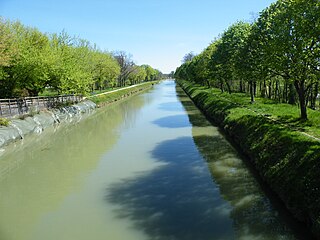
The Canal de la Sambre à l'Oise is a canal in northern France. It forms a connection between the canalised river Sambre at Landrecies and the Oise at La Fère. The canal is 71 kilometres (44 mi) long, and has 38 locks. The junction made at La Fère is with a branch of the Canal de Saint-Quentin, while the Canal latéral à l'Oise is joined 10.5 km further downstream at Chauny. It was used by the standard Freycinet-gauge péniches, 38.50 metres (126.3 ft) long, and 5.05 metres (16.6 ft) in beam, carrying up to 250 tonnes. The canal, also a popular waterway for boats heading south from the Netherlands and Belgium to the central French waterways, had to be closed in 2006 when two aqueducts were found to be in danger of failing. Funding has been put in place by the owner, Voies Navigables de France, and the local authorities, with support from the State, and it is expected to reopen the canal throughout in 2020.

The Sambre is a river in northern France and in Wallonia, Belgium. It is a left-bank tributary of the Meuse, which it joins in the Wallonian capital Namur.

The Aisne is a river in northeastern France. It is a left tributary of the Oise. It gave its name to the French department of Aisne. It was known in the Roman period as Axona.

The Aa is a river in northern France that is 93 km long. Originating near the village of Bourthes and emptying into the North Sea near Gravelines, the Aa is located near the north-eastern limit of the English Channel. The Aa has been canalized for most of its length and forms much of the border between the regions of Pas-de-Calais and Nord.

The Briare Canal is one of the oldest canals in France. Its construction started in 1604. It was the first summit level canal in Europe that was built using pound locks, connecting the Loire and Seine valleys. It is 57 kilometres long and is part of the Bourbonnais route from Saint-Mammès on the Seine to Chalon-sur-Saône on the Saône.

The Arrondissement of Calais is an arrondissement of France in the Pas-de-Calais department in the Hauts-de-France region. It has 52 communes. Its population is 158,492 (2016), and its area is 593.4 km2 (229.1 sq mi).

The Nantes–Brest canal is a French canal which links the two seaports of Nantes and Brest through inland Brittany. It was built in the early 19th century, and its total length as built was 385 km with 238 locks.

The Canal de la Marne au Rhin is a canal in north-eastern France. It connects the river Marne and the Canal entre Champagne et Bourgogne in Vitry-le-François with the port of Strasbourg on the Rhine. The original objective of the canal was to connect Paris and the north of France with Alsace and Lorraine, the Rhine, and Germany. The 313 km (194 mi) long canal was the longest in France when it opened in 1853.

The Canal du Rhône à Sète is a canal in southern France, which connects the Étang de Thau in Sète to the Rhône River in Beaucaire, Gard. The canal is made up of two previously constructed canals, the Canal des Étangs and Canal de Beaucaire. It connects with the Canal du Midi through the Étang de Thau.

The Canal du Nord is a 95-kilometre (59 mi) long canal in northern France. The canal connects the Canal latéral à l'Oise at Pont-l'Évêque to the Sensée Canal at Arleux. The French government, in partnership with coal-mining companies in the Nord and Pas-de-Calais departments, developed the canal to help French coal mining companies withstand foreign competition. Construction of the canal began in 1908 but halted in 1914, because of the First World War. The war caused widespread destruction of the canal and the French government made no attempt to resume construction until 1959. Construction recommenced in 1960 and the waterway opened to the public in 1965. The Canal du Nord and the Canal de Saint-Quentin may be supplanted by the Seine–Nord Europe Canal, a projected high capacity link between the Oise River at Janville and the high capacity Dunkirk-Escaut Canal.

The Seine–Nord Europe Canal is a planned high-capacity canal in France that would link the Oise River at Compiègne with the Dunkirk-Scheldt Canal, east of Arleux. It is the French part of a proposed Seine-Scheldt canal that would ultimately connect the Rhine and Seine basins inland. The stated objective is to expand trade flows in a fuel-efficient and ecologically friendly manner between the Seine basin and Belgium, Germany and the Netherlands, while reducing saturation on the A1 motorway in France and reducing the CO2 emissions in the transport sector within this corridor.

The Canal de l'Ourcq is a 108.1 km (67.2 mi) long canal in the Île-de-France region with 10 locks. It was built at a width of 3.20 m (10.5 ft) but was enlarged to 3.7 m (12 ft), which permitted use by more pleasure boats. The canal begins at Port-aux-Perches near the village of Troesnes, where it splits from the channeled river Ourcq, and flows to the Bassin de la Villette, where it joins the Canal Saint-Martin. Paris requires 380,000 cubic metres of water daily for cleaning the sewer system, gutters, and parks. The Canal de l'Ourcq provides about half of the requirement. Since 1983, the waterway has been designated for use by pleasure craft, and its water is designated for non-drinking uses.

Voies navigables de France is the French navigation authority responsible for the management of the majority of France's inland waterways network and the associated facilities—towpaths, commercial and leisure ports, lock-keeper's houses and other structures. VNF was established in 1991 and took over the responsibility for all waterways from the National Office of Navigation in 1993. It is a public body and is under the control of the Minister of Ecology, Energy, Sustainable Development and Territorial Development. The headquarters of VNF are in Béthune, Pas-de-Calais with local offices throughout France.

The Canal de l’Aisne à la Marne is a canal in northeastern France which connects the Aisne and the Marne valleys. It runs from the Canal latéral à l'Aisne at Berry-au-Bac to Condé-sur-Marne on the Canal latéral à la Marne, a distance of 58 km. The canal rises 40m through 16 locks via the cathedral city of Reims, which is also a busy commercial port, to a summit level at an altitude of 95.70m. After crossing the watershed through a tunnel 2302m long at Mont-de-Billy, the canal drops down 23.80m through a flight of 8 locks towards the Marne.

The Canal de l'Oise à l'Aisne is a summit level canal in the Hauts-de-France region, formerly Picardy. It connects the Canal latéral à l'Aisne at Abbécourt to the Canal latéral à l'Oise at Bourg-et-Comin.

The Canal de la Somme is a canal in northern France. Its total length is 156.4 km with 25 locks, from the English Channel at Saint-Valéry-sur-Somme to the Canal de Saint-Quentin at Saint-Simon.

The Dunkirk-Scheldt Canal is a 189 km long series of historic canals, and the canalised river Scheldt that were substantially rebuilt from the mid-1950s up to ca. 1980, with some new sections, from Dunkirk to the Belgian border at Mortagne-du-Nord. Existing canals were straightened and widened; and new locks were built, also on the river Scheldt, from the junction at Bouchain to the border. The route is also known as the Liaison 'à grand gabarit'Dunkerque-Escaut. Some authors have separated the waterway into the canal proper and the canalised river Scheldt, but current practice is to use the simple name throughout. The Liaison was designed for large commercial vessels up to 85m long by 11.50m wide. The entire route is being further upgraded to offer European Class Vb dimensions, for push-tows 185m by 11.50m, and motor barges up to 125m long, as part of the current EU-funded Seine-Scheldt-Rhine waterway corridor investments, including the new Seine-Nord Europe Canal.

The Canal de la Deûle is one of the oldest canals in northern France, originally connecting the river Scarpe near Douai with the river Lys at Deûlémont near the Belgian border. Roughly half of its original length has been absorbed in the high-capacity Dunkerque-Escaut waterway, as shown on the map, and the remaining length through the port of Lille is often considered as a branch of the main route, hence the alternative names Liaison or Antenne Bauvin-Lys. This official name was never adopted by the local population, which refers simply to the Deûle, evoking its original state as a natural river, although it has the size and the appearance of a built canal. It is 34.8 kilometres (21.6 mi) long with 3 locks.

The Canal de Montech is an 11 km waterway in southwestern France connecting the Canal de Garonne in Montech and the Tarn River in Montauban. It is also known as the Montauban Branch.

The Port of Calais is a port in Calais, northern France. The port is the fourth largest port in France and the largest for passenger traffic. It accounts for more than a third of economic activity in the town of Calais.




















